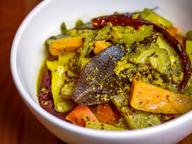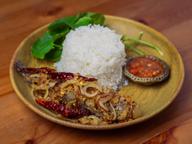dish
Canned stewed pork with potatoes
A humble stew of meltingly tender meat using an underrated star of home cooking—canned stewed pork.
Pinarasakan sada bambangan (Braised fish with wild mango)
When bambangan season rolls around, this braised fish is a delicious way to use up a glut of the fruit’s harvest.
Kurat kasam dihan (Splitgill mushrooms with tempoyak)
There isn’t much that tempoyak can’t improve, and cooking it with mushrooms both complement and enhance the overall umami of both ingredients.
Orh oh bak (Yam and pork in soy sauce)
A Hakka homestyle dish that became an instant classic in Zara’s home.
Hu chee rumpah (Sambal-stuffed fried fish)
Sambal-stuffed fish is a highlight at many nasi campur stalls; you can now make it at home.
Char swee (Stir-fried cucumber in vinegar)
Cooking cucumbers isn’t a novel method. This excellent Nyonya recipe shows us a tangy application for weeknight meals.
Malay wedding-style beef liver
All you’ll need for a kenduri at home are a glass of F&N rose syrup, nasi minyak, and a hearty helping of this dish.
Mrs Menon’s mango curry
A sweet introduction to the world of fruit curries, this mango curry is perfect for an Onam Sadhya lunch.
Luncheon meat masala
Turn a can of luncheon meat into a spicy dish, a perfect pantry meal to cook before grocery runs.
Braised turmeric chicken
When you want ayam kunyit but can’t bear the oily cleanup, turn to this braise instead.
Sardine sambal
Wonder why sardine sambal isn’t up your alley? Try this pre-frying technique and let us change your mind.
Simple tomato soup
Zhuzh up your everyday tomato soup with spices and raisins for a flavoursome lunch.
Linugu tanggalung kinayan limau om bawing (Roasted eggplant with lemon basil salad)
A smoky eggplant salad to accompany a variety of meals, from rice to steaks, or as a part of an appetiser platter.
Yellow chicken gulai
Chicken and coconut milk come together in a simple preparation of gulai kuning or masak lemak, perfect for a quick yet satisfying meal.
Aloo mutton keema
A versatile minced meat sauce that can be paired with your carb of choice for a complete meal or even a quick snack.
Terung Dayak with mackerel
This dish is a common staple on Diana’s family dining table, as her mom would buy terung Dayak whenever they were in season.
Banana heart kerabu
Rather than raw, this kerabu includes cooked elements that result in something like a masak lemak.
Sweet mango chutney
Unlike many other chutneys popular in the Malaysian-Indian repertoire, this one veers sweet and makes for a great snack on its own.
Fried rendang
Soft and tender chunks of meat without hours on the stove is not possible, but getting those spicy rendang flavours definitely is.
Creamy spicy chicken curry
This version of Malaysian-Indian chicken curry uses store-bought curry powder such as Baba’s, but is taken up a notch with extra spices.
Acar hu
This Nyonya-style fish pickle ticks all the tasty flavour boxes: tangy, fatty, savoury, sweet.
Tau eu bah
Grandma Ong incorporates spices not found in the original recipe, bringing a Nyonya punch to this crowd favourite.
Pumpkin masala
A subtly spiced and hearty side dish, unfussy enough for a weeknight.
Umbut sawit in belacan
Umbut sawit is the young shoot or heart of the oil palm tree. Plentiful in Borneo from the plantations, resourceful locals have found that it makes for a terrific ingredient.
Paeh ikan keli
The Temuan way to cook this fish is over the embers of an outdoor stove. We highly encourage you to go for it if you have a grill.
Ayam asam rong
This is a traditional recipe originating from Jerantut, Pahang, and has since spread to neighbouring areas in the state.
Gaeng som
This dish, inherited from Banyen’s late grandmother, makes an appearance at least twice a week on their dinner table at home.
Shukto
Leela’s late mother was the family’s ‘culinary comforter’, and taught her how to make this vegetable dish. Complex in flavour, this recipe takes no shortcuts.
Pekasam ikan
Many kampung folks catch freshwater fish as a cheap source of protein, and pekasam is a way of fermenting a glut of a catch.
Granny’s chicken pongteh
The slow braise of ingredients in this pong teh coax out every bit of flavour—it’s worth splurging on good chicken and soy sauces.
Shallot prawns
Between the char of the crispy shallots, the umami of the soy sauce, and the sweetness of the prawns, one really doesn’t need anything else.
Kangkung belacan
This is quite possibly the best version of kangkung belacan we’ve tried—spicy, briny and still-crunchy.
Hinava tenggiri
Hinava is a traditional native dish of the Kadazandusun people in the state of Sabah, which is a method of cooking saltwater or freshwater fish using lime juice.
Fenugreek fish sambal
The star of this dish is fenugreek, along with the freshest fish possible.
Chicken lihing soup
Natasha learned how to make this dish from her mother (who she assumes learned it from her mother), and craves it on gloomy rainy days.


































